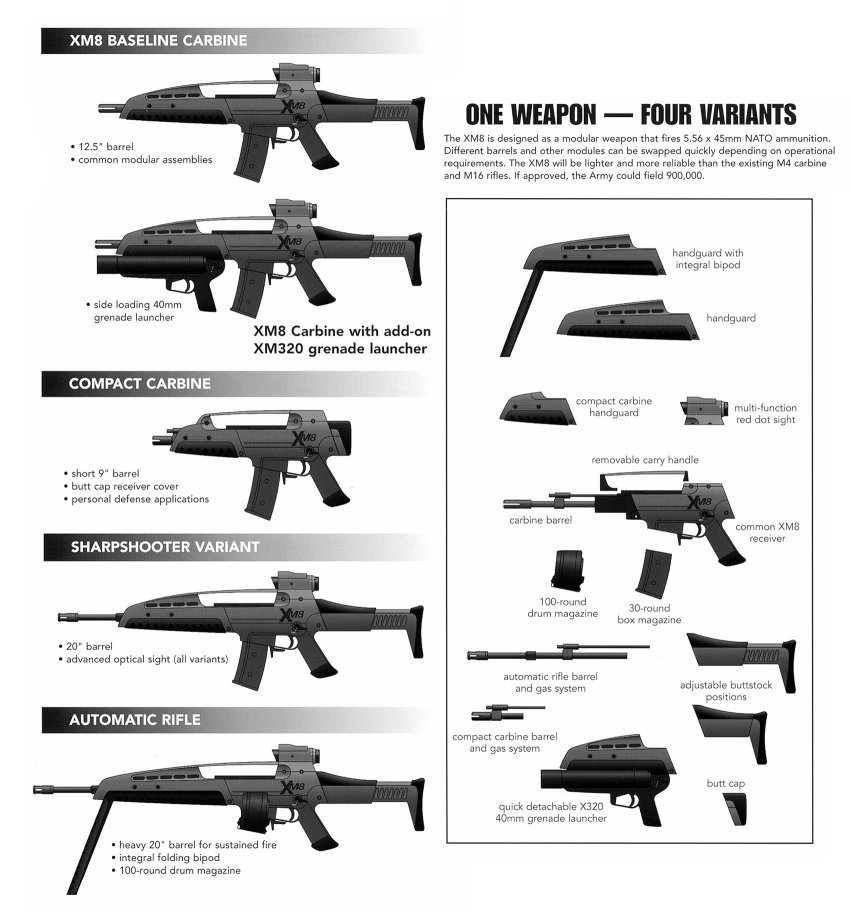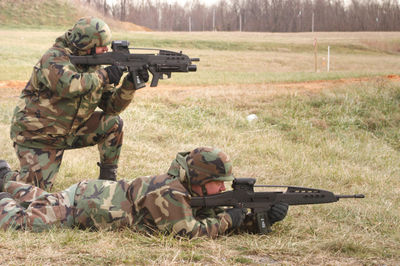KM-40
The KM-40 the primary combat rifle of the Karchozian Armed Forces. The design and functions of the rifle were based soley on the prototype weapon that was being created for the United States Army: the XM8. For unknown reasons, the XM8 was cancelled despite successful field tests.
Technical Specifics
Caliber: 5.56x45 mm NATO
Action: Gas-operated, rotating bolt
Overall length: 838 mm in basic configuration, butt extended
Barrel length: 318 mm in basic configuration; also 229 mm in Compact and 508 mm in Sharpshooter and SAW versions
Rate of fire: ~ 750 rounds per minute
Magazine capacity: 30 rounds or 100-rounds double drum in Automatic Rifle/SAW role
Background of the XM8 Project
The Army's purpose in contracting for this prototype weapon was to provide replacement options for the venerable M16 rifle after the XM29 program ran into problems. The Army's goal was a weapon that was cheaper, lighter, and more effective than the M16 and M4 Carbine series of weapons. The XM8 was not just one weapon, but a system which could be reconfigured with appropriate parts to be any one of several variants from a short-barreled personal defense weapon to a bipod-equipped support weapon. It also included an integrated optical sight and IR laser aiming module/illuminator.
The XM8 was based on the kinetic energy module of Alliant Techsystems's XM29 OICW project, of which the weapon mechanisms were the responsibility of H&K. Following the indefinite delay of the Objective Individual Combat Weapon program, the U.S. Army requested that the contractors design stand-alone weapons from the XM29's kinetic energy and high explosive modules.
The first 30 XM8 prototypes were delivered by November 2003 for preliminary testing. Later, at least 200 developmental prototypes were procured. Among the complaints during testing were too low a battery life for the weapon's powered sight system and some ergonomics issues. Two other key issues were reducing the weapon's weight and increasing the heat resistance of the hand guard, which would start to melt after firing too many rounds. The main testing was largely completed, and the Army pushed for funding for a large field test. However, in 2004 Congress denied $26 million funding for 7,000 rifles to do a wide scale test fielding of the XM8 in 2005. At the time the rifle still had developmental goals that were incomplete, primarily associated with the weapon's weight; the battery life had been extended, and a more heat-resistant plastic hand-guard added. The earliest product brochure lists the target weight for the carbine variant at 5.7 lb (2.6 kg) with the then current prototype at 6.2 lb (2.8 kg). The weight of the carbine prototype had since grown to 7.5 lb (3.4 kg) according to a brochure released by HK and General Dynamics in January 2005.
During the same period, the Army came under pressure from other arms makers to open up the XM8 to competition. The main argument was that the weapon that was being adopted was a substantially different system than for the original competition that ATK and H&K had actually won (see XM29). Other issues were that the Army has a legislated obligation to prefer U.S.-based manufacturers, and that a previous agreement with Colt Defense required the Army to involve Colt in certain small-arms programs. The XM8 program was put on hold by the Army in 2004. The exact reason why this happened is a matter of debate; some combination of the aforementioned technical issues, funding restrictions, and outside pressure being involved.
In 2005, the Army issued a request for proposal soliciting proposals for the OICW Increment One family of weapons. This RFP gave manufacturers six months to develop and deliver prototype weapons with requirements very similar to the XM8 capabilities, but with the addition of a squad automatic weapon (SAW) configuration. Currently, no XM8 prototypes have been shown that actually match the capabilities of the M249 (e.g. fast barrel replacement, high sustained rate of fire, belt feed). The OICW Increment One requirement for the SAW includes fast barrel replacement and high sustained rate of fire, but leaves the ammunition feed choice up to the manufacturer.
Funding for the XM320 grenade launcher, which is a single-shot under-barrel grenade launcher similar to the M203 that was originally intended for the XM8, was approved. The launcher is actually heavier than the M203, but does offer some advantages. The XM320 was designed for use with the existing inventory of M16s and M4s and is also compatible with the XM8. It can also be used as a stand-alone weapon.
As of July 19, 2005, the OICW Increment One RFP was put on an eight-week hold, with an indication given that the program was being restructured as a joint procurement program including the Army and unnamed other branches. On October 31, 2005, the OICW Increment One RFP was canceled until further notice.
In an article in Jane's Defence Weekly, April 26 2006 (Vol 43, page 30) we learn that "The US Army has again delayed the procurement of its future infantry weapons, this time for more than five years, and is working to field two interim guns in the meantime."


